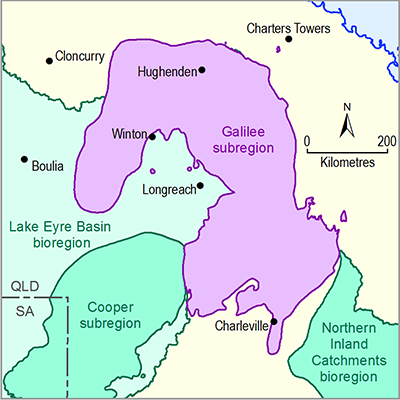Page 10 of 44
There are several geological data gaps for the Galilee subregion:
- Approximately 8% of all groundwater bores are missing drillhole depth measurements.
- Currently, approximately 70% of groundwater bores in the Galilee subregion either have no stratigraphic data, or do not have usable data for geological modelling. Also, data analysis workflows would be streamlined if existing stratigraphic data records could be standardised; for example, removing spelling errors or variations in spelling, errant characters and include (if available) top and bottom information for each stratigraphic entry. Most groundwater bores are missing ground elevation measurements. Additionally, some existing elevation data in Queensland Department of Natural Resources and Mines (Dataset 16) were recorded relative to a state elevation datum rather than the national elevation datum. It may be useful to convert existing elevation data as required so that they reference the national elevation datum.
- No reference elevation data are included in Queensland Department of Natural Resources and Mines (Dataset 16) for petroleum and CSG wells. While elevation data can be sourced from relevant well completion reports, workflows would be streamlined if these data could be included in the digital databases.
- Access to at least some company coal drilling data would greatly improve the accuracy of geological models in the vicinity of coal mine project areas along the eastern margin of the Galilee subregion. Not all of that drilling data would be required, but ideally bore location data, stratigraphic picks and, if possible, some geophysical well logs.
- Some bores drilled for stratigraphic investigations in the 1960s to 1970s appear to be missing stratigraphic data records. It would be useful to access and incorporate these missing data into the databases.
- The geological Galilee Basin boundary, in particular areas along its eastern margin, need to be updated in light of the geological modelling presented here. Any update should consider utilising regional geophysical datasets to refine the boundary and, if available, recent company coal and CSG drillhole data and more detailed surface mapping. Access to more detailed company geological mapping (including structural mapping) would also improve the Galilee geological models, particularly along the Galilee subregion’s eastern boundary. These data would assist in resolving the discrepancies that exist in available geological surface mapping.
- Some stratigraphic correlations, particularly in the upper Permian and Triassic sequences of the Galilee Basin, could be refined by more age dating and biostratigraphy. This would lessen uncertainty in regional correlation and thus geological modelling. Some of this work is already underway (e.g. Nicoll et al., 2015; Phillips et al., 2015, 2016). Future refinements of the Galilee subregion geological model should consider incorporating upper Permian stratigraphy outlined in Phillips et al. (2015, 2016) if data are available.
- Further detailed interpretation of existing two-dimensional seismic and geophysical well logs and incorporation of updated interpretations would improve geological models. If available seismic and well log information is considered fit for purpose, they could be used for other purposes such as distribution and variation in lithology, porosity and more detailed structural analysis.
- Although there is a general understanding of regional structure, there seems to be little available information on local structures that may exist in the Galilee subregion. More localised structures do exist and have been documented from recent reporting (Section 2.1.2.2.3). Use of regional geophysical datasets, and available seismic, well logs and coal company data are likely to provide further understanding on more local-scale structures. A more detailed understanding of structures would improve geological and hydrogeological modelling.
- Figure 33 shows the worst case scenario of uncertainty of Galilee basement position across the Galilee subregion. This is especially the case near basin margins and highlights the paucity of available stratigraphic control and the need for regional seismic transects to extend control across the entire subregion. Some of this uncertainty could potentially be alleviated by the incorporation of company drillhole data into the geological models.
- Present understanding of regional structure has evolved from regional mapping, seismic reflection surveys and exploration drilling. These investigations could be used to improve the interpretation of structural elements that are graphically indicated in potential field imagery, that of gravity and magnetics (Figure 8). Lower resolution datasets had been the basis of the OZ SEEBASE model of magnetic basement (de Vries et al., 2006), but with recent upgrading of dataset resolution, there is a need for a new iteration of interpretive modelling of magnetic basement. However, even with improvement in a modelled magnetic basement, the uncertainties of thickness of underlying sedimentary sequences in the Adavale, Drummond and Belyando basins remain dependent on additional seismic data, given the very limited number of drillholes in these areas.
- Knowledge of the thickness, structure and lithological variations within Cenozoic sequences is very limited across the Galilee subregion. One option that would improve understanding of the Cenozoic sediments would be acquisition of airborne electromagnetic (AEM) data in the subregion. If required, the AEM survey could be complemented by a shallow drilling program or use of existing company-supplied drilling data (if applicable), to provide stratigraphic control for modelling the thickness and characteristics of the near-surface cover. The AEM data would also provide information on shallow groundwater systems, and potentially identify areas of connectivity between Cenozoic cover and underlying regional GAB aquifers.
Last updated:
6 December 2018

Summary and download
Product Finalisation date
2018
PRODUCT CONTENTS
- 2.1.1 Geography
- 2.1.2 Geology
- 2.1.3 Hydrogeology and groundwater quality
- 2.1.4 Surface water hydrology and water quality
- 2.1.5 Surface water – groundwater interactions
- 2.1.6 Water management for coal resource developments
- Citation
- Acknowledgements
- Currency of scientific results
- Contributors to the Technical Programme
- About this technical product
ASSESSMENT
ASSESSMENT COMPONENT
